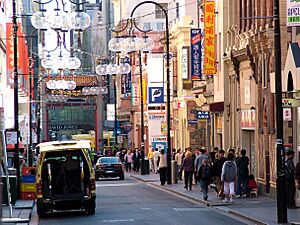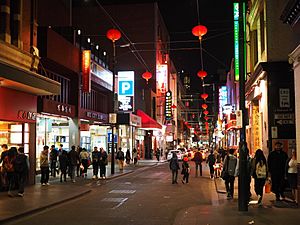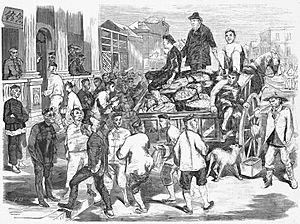Chinatown, Melbourne facts for kids
Quick facts for kids Melbourne Chinatown |
|||||||||||||||||
|---|---|---|---|---|---|---|---|---|---|---|---|---|---|---|---|---|---|
| Chinese | 墨爾本唐人街 | ||||||||||||||||
| Hakka | Med ngiˊ bunˋ tongˇ nginˇ gieˊ | ||||||||||||||||
|
|||||||||||||||||
| Alternative Chinese name | |||||||||||||||||
| Traditional Chinese | 墨爾本華埠 | ||||||||||||||||
| Simplified Chinese | 墨尔本华埠 | ||||||||||||||||
| Hakka | Med ngiˊ bunˋ faˇ pu | ||||||||||||||||
|
|||||||||||||||||
Chinatown in Melbourne is a special area in the city centre where many people of Chinese heritage have lived and worked for a long time. It's located at the eastern end of Little Bourke Street, stretching between Swanston and Spring streets. This vibrant area includes many small laneways, alleys, and arcades.
Chinatown was first created in the 1850s during the Victorian gold rush. It's famous for being the oldest Chinatown in the Southern Hemisphere and the longest-running Chinese community in the Western World.
Melbourne's Chinatown has been very important for Chinese immigrants in Australia. It's still a busy place with lots of Chinese restaurants, shops, cultural spots, and places of worship. Today, it's a popular tourist attraction. People love its old buildings, fun annual festivals, and delicious Asian food. You can also find karaoke places, cool bars, and fashion stores here.
Beyond the city centre, Melbourne's Chinese community also thrives in other suburbs like Box Hill. There, a big new development called "New Chinatown" is being built.
Chinatown is also home to the Chinese Museum, where you can learn all about Chinese Australian history.
Contents
History of Melbourne's Chinatown
The Gold Rush and Early Days (1850s–1890s)
In 1851, the Victorian gold rush began, attracting people from all over the world. Tens of thousands of Chinese came to Australia hoping to find gold. Most of these immigrants were men from villages in Hong Kong and nearby areas of China.
The eastern part of Little Bourke Street became a convenient place for these new arrivals. It was a good spot to rest and gather supplies before heading to the goldfields in central Victoria. The first places for people to stay were set up in Celestial Avenue, just off Little Bourke Street. By 1855, many Chinese homes and businesses filled Little Bourke Street.
Melbourne's Chinatown is special because it's the oldest Chinatown in the Southern Hemisphere. It's also the longest continuous Chinese settlement outside of Asia. This is partly because San Francisco's Chinatown had to move after a big earthquake in 1906.
As the gold rush slowed down, many people moved from the countryside into Melbourne. Little Bourke Street, which already had a large Chinese population, became even more central to the community.
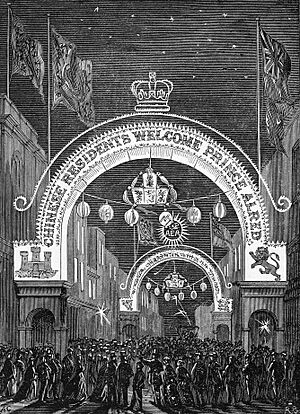
The people living in Chinatown started businesses as shopkeepers, importers, furniture makers, and herbalists. They also had a strong presence in the fruit and vegetable industry at the nearby Eastern Market. Christian churches were built, and Chinese political groups and newspapers were started. Chinatown also offered support to new Chinese immigrants.
By 1859, about 45,000 Chinese people lived in Victoria. This was nearly 8.5% of the colony's total population!
Some community leaders from Chinatown became very respected in Melbourne. These included businessman Lowe Kong Meng, police detective Fook Shing, and missionary Cheok Hong Cheong. Even some businesses run by Australians of European background were located in Chinatown during this time.
Growth, Challenges, and Revival (1901–Today)
Chinatown was at its biggest in the early 1900s. Businesses expanded into nearby areas. However, a new law called the Immigration Restriction Act 1901 made it much harder for people from certain countries, including China, to come to Australia. This law caused Chinatown's population to shrink. Also, many businesses and residents started moving from the city centre to the suburbs.
In the 1920s, more Australians of European background began to enjoy Chinatown's restaurants. This helped create a unique Australian Chinese cuisine. This style of food became very popular by the mid-1900s. The dim sim, a famous Australian Chinese snack, was invented in Chinatown in 1945 by William Wing Young at his restaurant, Wing Lee. It's now a popular snack all over the country! Young's daughter, Elizabeth Chong, became a famous TV chef and tour guide for Chinatown.
In the 1960s, a local leader named David Wang saw Chinatown's potential as a tourist spot. He pushed for changes to Little Bourke Street, which led to the beautiful archways you see today.
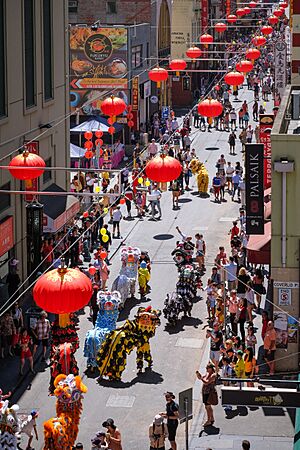
During the 1960s and 1970s, the strict immigration laws were removed. This led to many more people moving to Australia from places like Indochina, Singapore, Malaysia, Taiwan, Hong Kong, and China. As a result, Chinatown became even more diverse, with many different types of food and cultures.
In 2010, the ground floor of the Chinese Museum was updated to be a visitor centre for Chinatown. The next year, a memorial statue of Dr Sun Yat-sen was placed outside the museum. This celebrated 100 years since the founding of the Republic of China. The traditional Chinese New Year Lion Dance now finishes with a blessing of this statue.
Chinatown's Culture and Celebrations
Chinese New Year Festivities
The Chinese New Year is a huge celebration in Chinatown! It usually happens on the first Sunday of the new Lunar year. While the festival has grown to other parts of Melbourne, Chinatown is the original and main place for the celebrations.
The festivities include traditional and modern Chinese cultural activities. You can see amazing dances, Chinese opera, and singing. There are also karaoke competitions, many food stalls with delicious treats, arts and crafts, Chinese chess games, and fun events for children.
The exciting Dai Loong Dragon Parade and the main Lion Dances usually start around 10 am on the Sunday after New Year. They continue until about 4 pm. The Dragon parade begins and ends at Melbourne's Chinese Museum.
Asian Food Festival

The Asian Food Festival is typically held in Spring. It's a fantastic event that celebrates Asian cuisine. You can enjoy food tasting, visit many food stalls, and watch cooking demonstrations.
Other Chinese Communities in Melbourne
Besides the original Chinatown in the city centre, new Chinese communities have grown in Melbourne's eastern suburbs. Places like Box Hill, Glen Waverley, and Springvale now have large Chinese populations.
There's also an older Chinese community in the regional city of Bendigo, about 150 km north-west of Melbourne. This community also has links back to the gold rush days of the 1850s.
Chinatown in Books and Movies
Chinatown has inspired many artists and writers over the years!
Tom Roberts, a famous Australian artist, drew sketches of life in Little Bourke Street in the 1880s. During World War II, another artist, Eric Thake, created paintings of Chinatown shopfronts. These artworks are now kept in the State Library of Victoria.
The famous mystery novel The Mystery of a Hansom Cab (1886) by Fergus Hume is largely based on his observations of Little Bourke Street. The detective in the story even chases a suspect through the "dark recesses" of the Chinese Quarter.
Melbourne's first Chinese-language newspaper, the Chinese Times, published a novel called The Poison of Polygamy between 1909 and 1910. Written by Wong Shee Ping, it was the first novel written in Chinese to be published in Australia. It describes life in Chinatown during the 1850s gold rush.
A key scene in the 1911 silent film The Double Event takes place in Melbourne's Chinatown.
The 1997 Hong Kong action film Mr. Nice Guy, starring Jackie Chan, was filmed in Melbourne, with several scenes shot right in Chinatown.
Chinatown also appears in the detective TV show Miss Fisher's Murder Mysteries (2012–2015). One episode, "Ruddy Gore," focuses a lot on Chinatown and its connection to the theatre district.
Images for kids
-
The archway near Swanston Street
See also
- Heavenly Queen Temple (Melbourne)
- Chinese Museum, Melbourne


